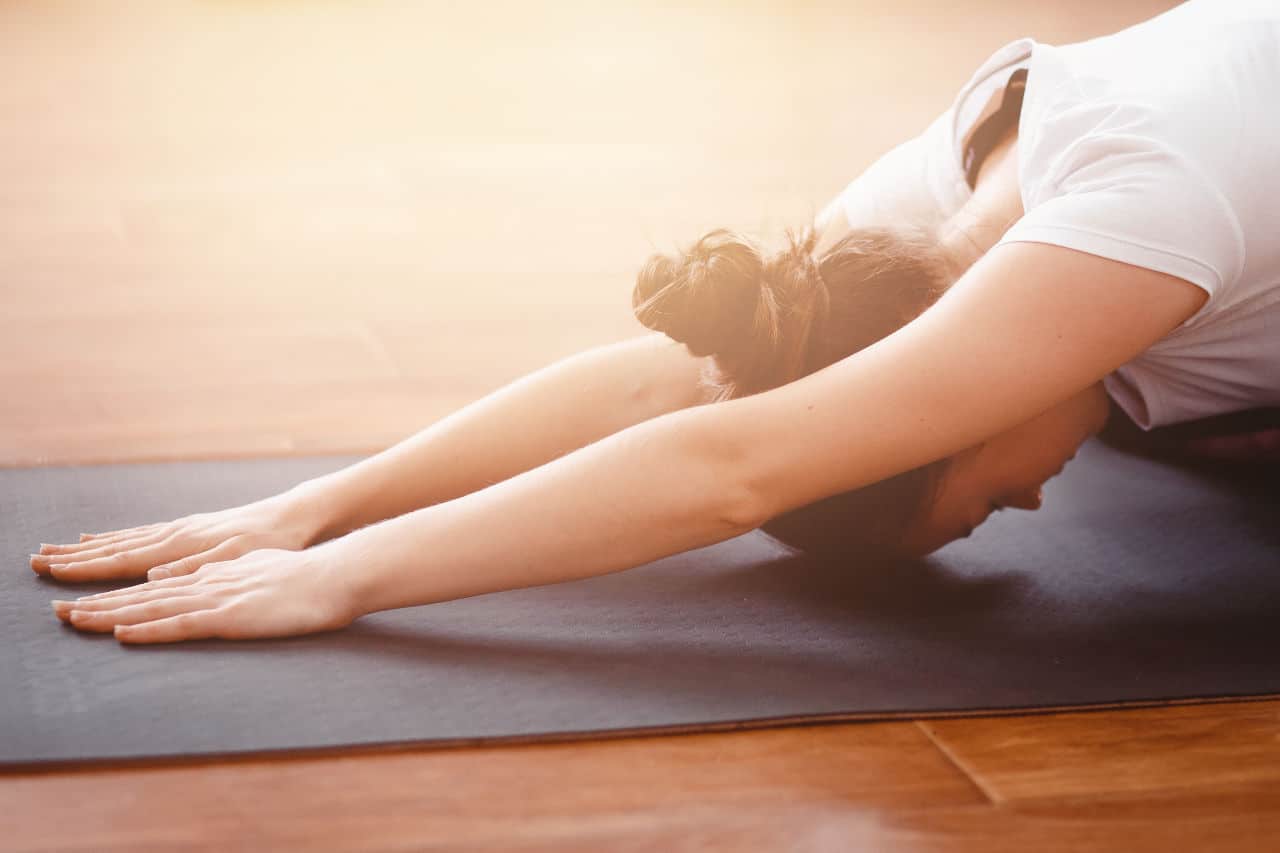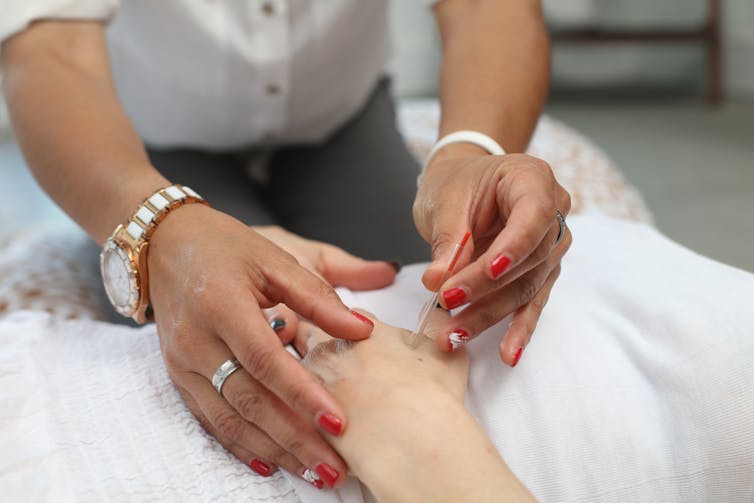Against back pain, moving more is not enough
"Back pain? The right treatment is movement." The slogan has been hammered home for the past two weeks on television and posters. Assurance-Maladie has launched its first national campaign to encourage people suffering from low back pain to get active.
Gregory Ninot, University of Montpellier
Shutterstock
The aim of the campaign, which runs until December 18, is to combat the common misconception that lying around is the best way to recover from kidney failure. Moving around more is certainly beneficial, but is it really that simple?
Back pain affects about 1 in 10 people. This persistent pain in the lumbar vertebrae, just above the coccyx, is known as benign or non-specific low back pain. It leads to restricted movement, increased sedentariness, recurrent negative thoughts, emotional difficulties and repeated work stoppages, as established by a study published in 2010.
Some people feel helpless: nearly 60% of people suffering from low back pain thinking they couldn't recover. They multiply treatments and care, without any lasting benefit. And the cost to the French health insurance system is skyrocketing. For example, a French study of a cohort of people treated by general practitioners showed that 81% of patients suffered from low back pain for more than a year, with an average total cost per patient of 715 euros over six months in 2007.
Patients' out-of-pocket expenses are also rising, as the French health insurance system reimburses only 35% to 70% of treatment costs, depending on the case.
Movement is necessary
Movement is the key to curing back pain, as underlined by the campaign. Taking the stairs instead of the elevator, stopping one metro or streetcar station earlier, using a bicycle whenever possible to get around, swimming - these are just a few of the answers. These physical efforts are a blessing in disguise, and far more effective than rest in overcoming lower back pain.

Rest is a bad reflex, acquired during episodic illnesses such as the flu. If you think you can cure low-back pain by resting, you're actually making it worse. The less people move, the less they feel able to move. Physical inactivity makes them more vulnerable to other health problems. Low-back pain becomes more complicated and chronic. This process is known as the vicious circle of deconditioning.
On the other hand, the danger lies in going too far, too fast, too hard. Taking pain-masking drugs, overdoing sports or "dealing with it" (blaming aging, overwork, burn-out, family constraints, etc.) may help you forget the pain, but they don't solve anything.
Move more, but not just any old way
Move more, yes, but not just any old way. Research is increasingly exploring the rich field of non-medicinal interventions. The French National Authority for Health (HAS),Inserm and the French Academy of Medicine are all taking an interest.

CEPS Platform Montpellier Universities
Non-medication interventions (NMIs) specific to low back pain will target muscular aspects (such as postural muscle strengthening), neuromuscular aspects (such as flexibility), neurological aspects (such as pain management), postural aspects (such as workstation), psychological aspects (such as pain desensitization and stress regulation), social aspects (such as work organization) and environmental aspects (such as bedding).
These NMIs call on the services of trained professionals, such as physiotherapists, osteopaths, acupuncturists, instructors in adapted physical activity (APA), psychologists or therapeutic education professionals.
Defining the dose, intensity and frequency of these NMIs for each individual is essential to achieving satisfactory results.
Non-drug interventions have been the subject of clinical studies evaluating their efficacy in the treatment and prevention of low back pain. These include Pilates, dru yoga (a form of yoga practised in Great Britain), tai chi, adapted physical activity programs, osteopathy, chiropractic, acupuncture, spa treatment, the Back School method (an American "back school" founded in 1969), the McKenzie method (founded in New Zealand in 1981) and therapeutic patient education.

Antonika Chanel/Unsplash
An osteopathic program specifically for low back pain
Some studies are particularly interesting. For example, the clinical trial conducted by the team of British physician and researcher Nefyn Howard Williams evaluated the benefits of an osteopathic method in people suffering from acute and sub-acute (i.e. low-intensity) spinal pain. The randomized controlled trial included 201 people aged between 16 and 65. They had consulted their general practitioner for neck or back pain that had appeared between 2 and 12 weeks previously.
Comparisons between the group receiving standard care only and the group receiving 3 to 4 osteopathic sessions with a trained physician were carried out on three occasions: before the start of the intervention, at the end of the intervention (i.e. 2 months later) and six months after the intervention. Measures included spinal pain-related health status, quality of life, sensory and affective dimensions of pain, and the relationship between cost and effectiveness of care received.
Osteopathic sessions were spaced one to two weeks apart, with a maximum interval of two months. The program included manual techniques and advice on regular physical activity. At the end of the two-month osteopathic intervention, the results showed a reduction in spinal pain intensity and an improvement in quality of life compared to the control group.
After six months, quality of life remained superior to the control group. However, pain levels no longer differed between the two groups. Health care costs specific to spinal pain were significantly higher for the osteopathic intervention group (88 euros per patient in total).
Psychotherapy for low back pain
Another study, this time involving psychotherapy. The trial conducted by Swedish researcher Steven Linton's team, published in 2015, evaluates the effectiveness of an intervention conducted with workers and their employers to prevent disability due to back pain. The intervention was compared with the usual management of low-back pain.
140 people aged between 27 and 65 took part in the study, which was carried out in a Swedish nursing home. They suffered from low-back pain, with a high risk of developing a chronic musculoskeletal disorder. For each person, the researchers counted days lost from work due to musculoskeletal disorders, use of medical care, perceived health status and pain intensity. Measurements were taken before and after the intervention, and six months afterwards.
Participants in the test group also received a brief psychological intervention based on the principles of cognitive-behavioural therapy (CBT). They participated in three face-to-face sessions with a clinical psychologist. Each session lasted between 60 and 90 minutes. The main aim of the intervention was to increase the workers' ability to deal with the difficulties associated with their experience of pain on a daily basis, particularly in the workplace.
The study showed a two-fold reduction in the average number of days off work six months after the intervention (38 days instead of 17). The difference was statistically significant compared with the control group. The researchers also noted an improvement in perceived health and a reduction in healthcare utilization for the test group. Pain intensity was identically reduced in both groups.
Yoga, a relevant non-medication intervention
Yoga, too, is among the relevant non-drug interventions for low back pain. A meta-analysis published in January 2017 reviews all scientific studies on the use of yoga in low back pain and indicates benefits. These yoga programs include physical exercises, breathing exercises, relaxation and meditation techniques. They promote mindfulness and strengthen the connection between body and mind.
Where can I turn for help with back pain? The role of the general practitioner and/or specialist is to identify the origin of the pain, its severity and its evolution. He or she can then propose the non-medicinal intervention best suited to the patient's low-back pain - or even several of them. This may be in addition to pain medication. This choice is made on the basis of the best balance between benefits and risks, based on scientific data, the doctor's experience, the patient's preference and the feasibility of the intervention.
![]() General practitioners and specialists increasingly familiar with NMIs and the local network of professionals who run them. Mutual insurance companies are beginning to reimburse some of these services. To combat back pain, you need to move more, but above all you need to move better.
General practitioners and specialists increasingly familiar with NMIs and the local network of professionals who run them. Mutual insurance companies are beginning to reimburse some of these services. To combat back pain, you need to move more, but above all you need to move better.
Gregory NinotProfessor of Health, Psychology and Sports Science, University of Montpellier
Visit original version of this article was published on The Conversation.